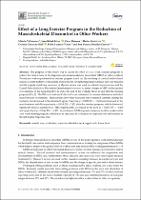Por favor, use este identificador para citar o enlazar este ítem:
https://repositorio.usj.es/handle/123456789/482
Registro completo de metadatos
| Campo DC | Valor | Lengua/Idioma |
|---|---|---|
| dc.contributor.author | Villanueva, Alberto | - |
| dc.contributor.author | Rabal-Pelay, Juan | - |
| dc.contributor.author | Berzosa Sánchez, César | - |
| dc.contributor.author | Gutiérrez, Héctor | - |
| dc.contributor.author | Cimarras-Otal, Cristina | - |
| dc.contributor.author | Lacárcel-Tejero, Belén | - |
| dc.contributor.author | Bataller-Cervero, Ana Vanessa | - |
| dc.date.accessioned | 2021-02-17T16:20:34Z | - |
| dc.date.available | 2021-02-17T16:20:34Z | - |
| dc.date.issued | 2020-12-04 | - |
| dc.identifier.citation | Villanueva, A., Rabal-Pelay, J., Berzosa, C., Gutiérrez, H., Cimarras-Otal, C., Lacarcel-Tejero, B., and Bataller-Cervero, A. V. (2020). Effect of a long exercise program in the reduction of musculoskeletal discomfort in office workers. International Journal of Environmental Research and Public Health, 17(23), 1-10. doi:10.3390ijerph/17239042 | es_ES |
| dc.identifier.issn | 16617827 | es_ES |
| dc.identifier.uri | https://repositorio.usj.es/handle/123456789/482 | - |
| dc.description.abstract | The purpose of this study was to assess the e ect of a six week exercise program to reduce the muscle tone of the trapezius and musculoskeletal discomfort (MED) of o ce workers. Twenty-six workers performed an exercise program based on: (1) stretching of cervical and/or dorsal region; (2) joint mobility of shoulders and rachis; (3) strengthening deep stabilizer and core muscles; and (4) scapula stabilizing exercises. A Myoton device was used to evaluate trapezius tone and the Cornell Musculoskeletal Discomfort Questionnaire was used to assess changes in MED at three points of evaluation: at the beginning (Pre_1) and at the end of the workday (Post_1), and after the training program (Pre_2). The Wilcoxon test and Cohen’s d were performed to examine di erences and e ect sizes between evaluations. Main results show that trapezius tone remained constant during the workday, but decreased in the dominant upper trapezius (p = 0.003, ES = 0.60) and increased in the non-dominant middle trapezius (p = 0.016, ES = 0.45) after the exercise program, which eliminated significant muscle asymmetries. MED significantly decreased in the neck (p = 0.027, ES = 0.60) and upper back (p = 0.046, ES = 0.67). In conclusion, MED appears to improve in o ce workers after a six week training program, which may be explained by a decrease in trapezius tone and increase in the left middle trapezius tone. | es_ES |
| dc.format.extent | 10 p. | es_ES |
| dc.format.mimetype | application/pdf | es_ES |
| dc.language.iso | eng | es_ES |
| dc.publisher | MDPI AG | es_ES |
| dc.relation | LMP195_18 | es_ES |
| dc.relation.requires | Requiere Adobe PDF | es_ES |
| dc.rights | Atribución 4.0 Internacional | * |
| dc.rights | Atribución 4.0 Internacional | * |
| dc.rights.uri | http://creativecommons.org/licenses/by/4.0/ | * |
| dc.subject | Muscle tone | es_ES |
| dc.subject | Workplace | es_ES |
| dc.subject | Trapezius | es_ES |
| dc.subject | Shoulder | es_ES |
| dc.subject | Neck | es_ES |
| dc.subject | Upper back | es_ES |
| dc.subject | Lower back | es_ES |
| dc.title | Effect of a long exercise program in the reduction of musculoskeletal | es_ES |
| dc.type | info:eu-repo/semantics/article | es_ES |
| dc.subject.unesco | Medicina del trabajo | es_ES |
| dc.identifier.doi | 10.3390/ijerph17239042 | es_ES |
| dc.rights.accessrights | info:eu-repo/semantics/openAccess | es_ES |
| Aparece en las colecciones: | Artículos de revistas | |
Ficheros en este ítem:
| Fichero | Descripción | Tamaño | Formato | |
|---|---|---|---|---|
| Effect of a long exercise program in the reduction of musculoskeletal.pdf | 323,04 kB | Adobe PDF |  Visualizar/Abrir |
Este ítem está sujeto a una licencia Creative Commons Licencia Creative Commons

